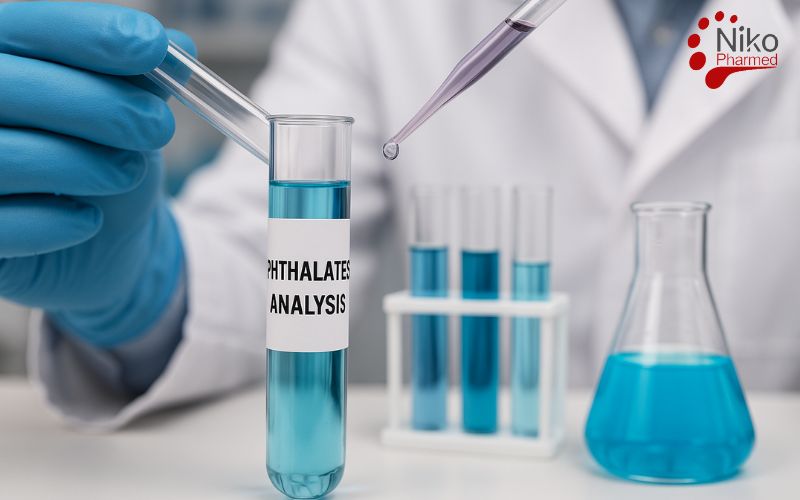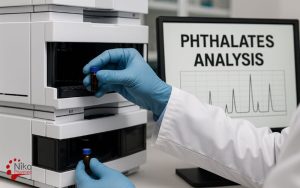What are Phthalates?
Phthalates are a group of chemical compounds mainly used as plasticizers, meaning they make plastics like PVC more flexible, durable, and soft. For medical devices, phthalate content evaluation is usually integrated into broader biocompatibility testing to ensure patient safety
They are commonly found in products such as packaging, toys, medical devices, cosmetics, and household items, but are also of concern because of their potential health and environmental impacts.
What is Phthalates Analysis?
Phthalates analysis is the systematic detection, identification, and quantification of phthalate esters (dialkyl or alkyl aryl esters of phthalic acid) in various matrices using advanced analytical chemistry techniques.
Because phthalates are not chemically bound to the plastics they soften, they can migrate, leach, or off-gas into air, food, water, or the human body. Detecting and quantifying them is critical for toxicological assessment, regulatory compliance, and risk management. In comprehensive chemical safety programs, phthalates analysis is often combined with heavy metals analysis to provide a complete contamination profile of plastics, packaging, and medical devices.
Analytical Objectives
Identification : Determining which phthalates are present (e.g., DEHP, DBP, BBP, DINP, DIDP, DMP).
Quantification : Measuring the concentration of each phthalate in a given sample.
Compliance Check : Ensuring levels meet regulatory standards (e.g., EU REACH, US FDA, EPA, and CPSC restrictions).
Toxicological Evaluation : Assessing potential exposure risks to humans and ecosystems.
Phthalates Analysis Test Methods
Gas Chromatography–Mass Spectrometry (GC–MS)
Gas Chromatography (GC): Separates compounds based on volatility and interaction with the column’s stationary phase.
Mass Spectrometry (MS): Identifies molecules by their mass-to-charge ratio (m/z) after ionization.
Why Used for Phthalates?
Phthalates are generally semi-volatile and thermally stable → ideal candidates for GC.
GC–MS provides excellent resolution among structurally similar phthalates.
Sensitivity can reach parts-per-billion (ppb) levels.
Advantages
Gold standard for most phthalates (DEHP, DBP, BBP, DINP, DIDP, etc.).
High specificity due to unique mass spectra “fingerprints”.
Quantitative analysis with internal standards ensures accuracy.
Limitations
Not ideal for highly polar phthalate metabolites (e.g., monoesters in urine).
Requires derivatization for some polar compounds to improve volatility.
High-Performance Liquid Chromatography (HPLC) with UV or MS Detection
HPLC: Separates compounds based on their polarity and solubility in mobile and stationary phases.
Detectors:
UV detector for compounds absorbing UV light (aromatic rings in phthalates).
Mass Spectrometry (LC–MS/MS): For precise identification and quantification at low concentrations.
Why Used for Phthalates?
Suitable for less volatile or thermally labile phthalates that degrade under GC conditions.
Essential for biological monitoring: phthalate monoester metabolites in urine, serum, and plasma are best analyzed by LC–MS/MS.
Advantages
No need for derivatization → direct analysis of polar metabolites.
Works well with complex biological or food matrices.
MS/MS provides high sensitivity and selectivity (trace levels).
Limitations
Lower chromatographic resolution compared to GC for volatile phthalates.
UV detection alone may lack specificity (possible interference from co-eluting compounds).
More expensive when using LC–MS/MS.
Fourier Transform Infrared Spectroscopy (FTIR)
FTIR measures infrared absorption of chemical bonds in a sample.
Phthalates, due to their ester functional groups and aromatic rings, show characteristic IR absorption peaks (e.g., C=O stretching around 1720 cm⁻¹, C–O stretching around 1270 cm⁻¹).
Why Used for Phthalates?
Rapid screening tool to detect the presence of phthalates in bulk plastic materials.
Useful for quality control in manufacturing or regulatory inspections.
Advantages
Non-destructive and requires minimal sample prep.
Quick analysis compared to GC–MS or HPLC.
Can confirm functional groups related to phthalates.
Limitations
Not quantitative for trace-level analysis.
Overlapping absorption peaks can cause interference.
Cannot distinguish between closely related phthalates as precisely as GC–MS.
Test Methods Comparative Table
| Technique | Best For | Strengths | Limitations |
|---|---|---|---|
| GC–MS | Volatile/semi-volatile phthalates in plastics, food, environment | High sensitivity, specificity, regulatory gold standard | Not ideal for polar metabolites; some derivatization needed |
| HPLC (UV/LC–MS) | Thermally unstable or polar phthalates; metabolites in urine/blood | Direct analysis, highly sensitive with MS, great for biomonitoring | Lower resolution vs GC; UV may lack specificity |
| FTIR | Screening bulk polymers for phthalates | Rapid, non-destructive, minimal prep | Not quantitative, poor selectivity for similar compounds |
In essence:
- GC–MS = Most powerful for environmental & product phthalates.
- HPLC/LC–MS = Best for biological/pharmaceutical monitoring.
- FTIR = Quick screening tool for plastics, not detailed quantification.
Nikopharmed Phthalates Analysis Laboratory
Global Recognition
ISO/IEC 17025-certified and ILAC-accredited, Nikopharmed delivers phthalates analysis data recognized worldwide by regulatory authorities.
Technical Excellence
We conduct GLP-compliant studies using advanced analytical methods including GC-MS, LC-MS, HPLC, and FTIR. Our services cover:
- Quantitative determination of regulated phthalates (DEHP, DBP, BBP, DINP, DIDP, etc.)
- Migration and leaching studies from plastics, food packaging, and medical devices
- Environmental monitoring of phthalates in air, soil, and water
- Biomonitoring of phthalate metabolites in biological samples
Regulatory-Ready Reports
Our traceable and scientifically robust reports support:
- Regulatory submissions under EU REACH, US FDA, CPSC, and EPA frameworks
- Consumer product safety testing (toys, cosmetics, packaging(For mentioned items where volatile organic compounds and residual monomers are critical, we also support clients with formaldehyde testing as part of broader chemical safety assessments))
- Medical device evaluations (blood bags, tubing, catheters)
- Quality control testing for manufacturing and supply chains
Confidential & Secure
21 CFR Part 11-compliant systems ensure data integrity, security, and full regulatory traceability, giving you complete confidence in compliance-driven testing.
Cost-Effective Solutions
We provide flexible study designs and competitive pricing, tailored to the needs of biopharma companies, medical device manufacturers, consumer goods producers, and regulatory bodies.
To request testing or a complimentary consultation contact Nikopharmad
Nikopharmed; Your Trusted Partner in Phthalates Analysis
By combining precision, compliance, and confidentiality, Nikopharmed delivers defensible phthalates analysis results that help accelerate global approvals, safeguard public health, and ensure regulatory compliance.


